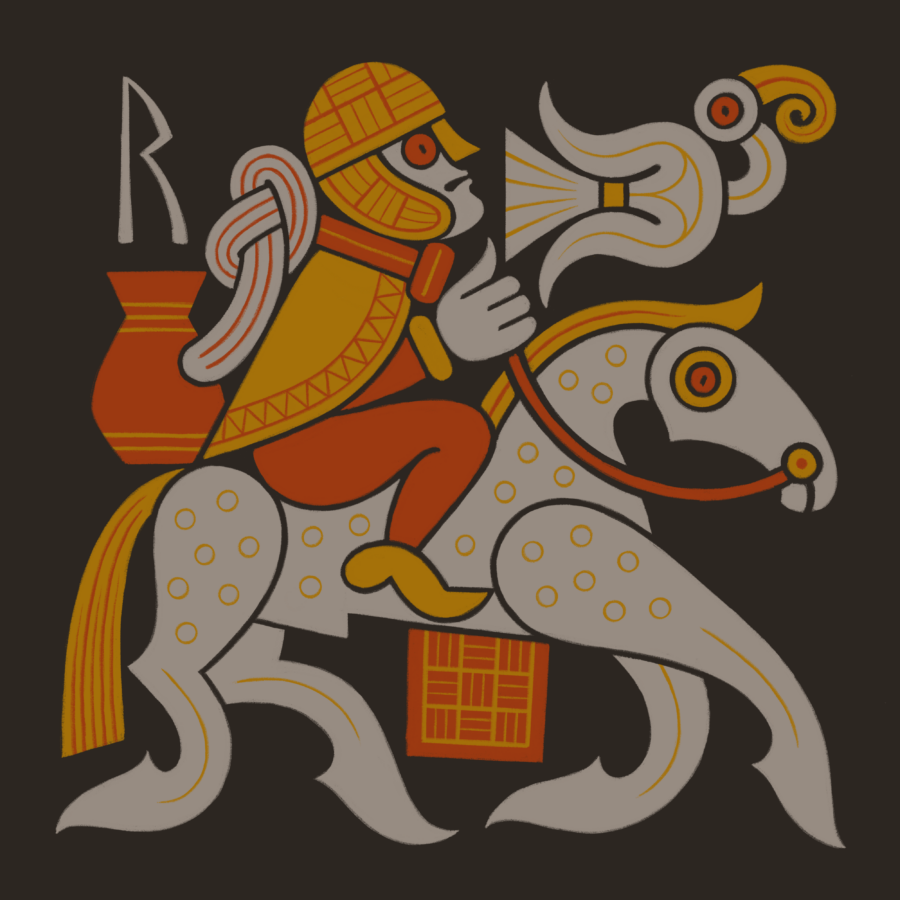
ᚱ raiðō
May 23, 2024
Ride
The poems all agree on the name and meaning of the rune being ‘ride’. There also seems to be a somewhat general theme of a dichotomy between riding being strenuous on the horse and easy for the seated rider, whether on the horse’s back or in the hall on a mental journey.
The Norwegian poem also mentions Regin creating the sword, Gramr, with which Sigurðr kills the dragon Fáfnir and obtains his treasure. Thus referencing the Völsunga saga, the most iconic legend of the time.
In the sagas, and especially in mythology, a ride is often associated with transversing the boundaries of the material world or crossing the threshold between realms, an inherently dangerous act with usually irreversible consequences.
The image is composed of an armoured woman riding a horse with a swan flying before her. Wearing armour was a normative masculine act; by doing so while also presenting as a woman by, for example, wearing her hair in a normative female hairdo, she transgressed cultural solid gender norms. She is a valkyrie (from Old Norse: valkyrja, meaning ’chooser of the slain’). One of their characteristics was that they were known to be able to shapeshift into swans. One of their roles in mythology was to collect the slain warriors from the battlefield, bringing them into the afterlife.
Below the stomach of the valkyrie’s horse hangs a square cloth divided into nine equal sections. In the sagas (Jómsvíkinga saga and Darraðarljóð), a group of valkyries weaves a piece of cloth on a loom before heading to the battlefield to collect the slain. The loom’s frame is made of spears, and the shed stick is a sword. The warp and weft are made of the intestine of men, and the weights are skulls. When they are done weaving, they tear the cloth apart, each taking a piece.
The craft of weaving belongs to the realm of women in early medieval Scandinavia and is directly connected to seiðr, the practice of magic and divination. The word seiðr originally meant string, ribbon or thread. This connects them intimately with the ambiguous and fluid group of norns and disir, all deities tied to the realm of women.
The societal expectation of the time was to act in accordance with one’s assigned gender. Crossing the boundaries of the binary gender roles was usually harshly condemned and could have severe negative implications for the individual, as well as their family. However, the act of gender transgression was also an act of stepping into a powerful liminal state. At the same time, exceedingly dangerous and uncontrollable, as well as extraordinarily magical and thus exceptionally powerful.
The valkyries, by taking up arms and thereby acting in a distinctly masculine manner while at the same time engaging in normative female activities like weaving and wearing dresses, clearly operate in this liminal and extra-potent, hyper-pregnant supernatural space. They are figures capable of riding across the threshold between life and the afterlife.
English Rune Poem
Ride — is relaxing for hall-resting warriors,
and sorely strenuous for someone bestriding
a mighty mount wandering the roads for miles.
Original language:
Rād — byþ on recyde rinca gehwylcum
sēfte, and swīþhwæt ðām ðe sitteþ onufan
mēare mægenheardum ofer mīlpaþas.
Icelandic Rune Poem
Ride — is the seated’s solace
and swift journey
and horse’s hardship.
Original language:
Reið er sitjandi sæla
ok snúðig ferð
ok jórs erfiði.
Norwegian Rune Poem
Ride — is worst for a stallion;
Regin forged the best weapon.
Original language:
Ræið — kveða rossom væsta;
Reginn sló sværðet bæzta.
Swedish Rune Poem
Ride – horse jumping.
Original language:
Ridher — hästespring.